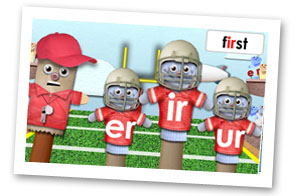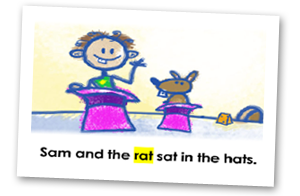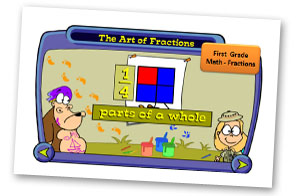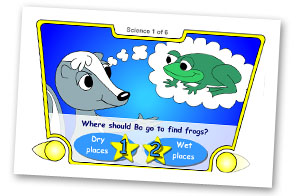First Grade Overview
Time4Learning is an online student-paced learning system covering preschool through middle school. It is popular as a first grade homeschool curriculum, for afterschool enrichment, for remediation, and for summer study.
For first graders, Time4Learning provides language arts, math, science and social studies. Students also get access to an online playground.
This page provides:
Overview of First Grade Learning Objectives
This section provides a summary of the key first grade learning objectives for reading, language arts, and math. A more detailed description of each subject is provided below, including links to detailed descriptions of the hundreds of learning activities. The Time4Learning language arts and math curriculum correlate to state standards.
First grade is a year of highly visible progress in reading and language arts. The major milestones in first grade reading and language arts are:
- Knowing the names and sounds of all the consonants and vowels
- Understanding phonics concepts such as consonant combinations
- Following along, reading, and summarizing simple stories with pictures
- Developing an understanding of composition
First grade is also a year of exploration and discovery of the numbers in the world around us. Major milestones for 1st grade math include:
- Counting to 100 by 1’s and skip counting
- Knowing the addition math facts
- Adding and subtracting small numbers
- Understanding the value of money
- Knowing the units for measurement, time, and weight
Below, there is a more in-depth description of the first grade curriculum for language arts, math, science, and social studies as well information about the online playground.
The language arts is GREAT for helping with phonics and beginner reading skills... Plus, the lessons are thoroughly entertaining!
Here at Letter Stadium, first graders learn
about "r-controlled vowels" from the
Phonics Football Players.
First Grade Language Arts & Reading - Lesson Overview
The language arts section contains 376 learning activities that are primarily based on phonics. Lessons are taught by colorful animated characters that sing, explain, and interact with the students. Reading exercises at the end of each chapter introduce and develop readiness and comprehension skills. It constitutes a solid first grade language arts program, correlated to state standards.
Three hundred seventy-six lessons are organized into thirteen chapters that introduce and cover:
- Consonants & Short Vowels - Teaches the relationship of sounds to letters of the alphabet. Exercises build phonemic awareness, phonics, and reading skills. First graders learn to identify the sight and sound of each and demonstrate knowledge of high frequency words. An interactive “think and respond” story will build sight word vocabulary, sound-spelling skills and reading comprehension.
- Digraphs & Vowels - Teaches the sounds and letters of the consonant digraphs ck, sh, th; the long vowel digraph ea; and the r-controlled vowel ar. Exercises build phonological awareness, phonics, and reading skills. First graders will identify each and demonstrate knowledge of high frequency words. An interactive “think and respond” story will build sight word vocabulary, sound-spelling skills and reading comprehension.
- Digraphs & Long Vowels - Teaches the sounds and letters of the consonant digraphs ng, ch, and the long vowel a. Activities build phonemic awareness, phonics, and reading skills. First graders will identify each and demonstrate knowledge of high frequency words. An interactive “think and respond” story will build sight word vocabulary, sound-spelling skills and reading comprehension.
- R-controlled Vowels, Digraph & Soft C - Teaches the sounds and letters of the r-controlled vowels er, ir, and ur; the consonant digraph wh, and the soft sound of the consonant c. Activities build phonemic awareness, phonics, and reading skills. First graders will identify each and demonstrate knowledge of high frequency words. An interactive “think and respond” story will build sight word vocabulary, sound-spelling skills and reading comprehension.
- Long Vowels, Suffixes & Plurals - Teaches the sounds and letters of CVCe words i_e and o_e; the suffixes ed and ing; and plurals s and es. Activities build phonemic awareness, phonics, and reading skills. First graders will identify each and demonstrate knowledge of high frequency words. An interactive “think and respond” story will build sight word vocabulary, sound-spelling skills and reading comprehension.
- Soft G and R-controlled Vowels - Teaches the sounds and letters of the r-controlled vowels or and ore and the soft sound of the consonant g. Activities build phonemic awareness, phonics, and reading skills. First graders will identify each and demonstrate knowledge of high frequency words. An interactive “think and respond” story will build sight word vocabulary, sound-spelling skills and reading comprehension.
- Long, Variant & Vowel Digraphs - Teaches the sounds and letters of CVCe words a_e, e_e, i_e, o_e, and u_e; the variant vowel all; and the vowel digraphs ai and ay. Activities build phonemic awareness, phonics, and reading skills. First graders will identify each and demonstrate knowledge of high frequency words. An interactive “think and respond” story will build sight word vocabulary, sound-spelling skills and reading comprehension.
- Long Vowels - Teaches the sounds and letters of the vowel pair ee; the long sound of i with the igh spelling; and the long sound of e with the y spelling. Activities build phonemic awareness, phonics, and reading skills. First graders will identify each and demonstrate knowledge of high frequency words. An interactive “think and respond” story will build sight word vocabulary, sound-spelling skills and reading comprehension.
- Long Vowels & Vowel Digraphs - Teaches the sight and sound of the consonant y and it’s vowel digraph ie; and the long o sound of vowel digraphs oa and ow. Activities build phonemic awareness, phonics, and reading skills. First graders will identify each and demonstrate knowledge of high frequency words. An interactive “think and respond” story will build sight word vocabulary, sound-spelling skills and reading comprehension.
- Variant Vowels and Diphthongs - Teaches the sounds and letters of the short sound of the variant vowel oo as in book; and the diphthongs ow and ou. Activities build phonemic awareness, phonics, and reading skills. First graders will identify each and demonstrate knowledge of high frequency words. An interactive “think and respond” story will build sight word vocabulary, sound-spelling skills and reading comprehension.
- Variant Vowels - Teaches the sounds and letters of the long sound of the variant vowel oo as in spoon; and the variant vowels ue and ew. Activities build phonemic awareness, phonics, and reading skills. First graders will identify each and demonstrate knowledge of high frequency words. An interactive “think and respond” story will build sight word vocabulary, sound-spelling skills and reading comprehension.
- Variant Vowels, Contractions, Diphthongs & Compound Words - Teaches the sounds and letters of the variant vowel aw; contractions; the diphthongs oy and oi; and compound words. Activities build phonemic awareness, phonics, and reading skills. First graders will identify each and demonstrate knowledge of high frequency words. An interactive “think and respond” story will build sight word vocabulary, sound-spelling skills and reading comprehension.
- Reading Comprehension, Vocabulary & Fluency - Students will learn new vocabulary, read a leveled story and demonstrate comprehension by recalling details. First graders develop fluency through a series of vocabulary, reading comprehension and writing activities that incorporate discovery learning and direct instruction.
This story is constructed using the "consonant - vowel - consonant" and "sight" words that were just taught.
In the lesson, you can click on the
highlighted word and hear it spoken.
First Grade Language Extensions - Lesson Overview
The language arts extensions is a complete alternative language arts curriculum. It contains 22 chapters made up of 289 activities, 182 worksheets, 44 quizzes and 22 chapter tests.
Many parents have their students work through the language arts section and feel that their children have mastered the materials. Other parents use sections of the language arts extensions for review and reinforcement of specific areas where their children have difficulty. Other parents have their children complete both sections in their entirety.
Each chapter starts with a story that introduces vocabulary, develops reading skills and enhances phonemic awareness. Through a series of learning activities focused on discovery, recognition, and application, first graders will learn to generate ideas, demonstrate comprehension of a theme, create graphic organizers and write diary entries.
At the end of each chapter, the “Story Creator” teaches first graders to apply their knowledge and use their reading skills to compose grammatically correct sentences and stories.
The twenty-two language arts extension chapters include: |
1. Pollution
2. Oceans
3. Weather
4. The Sun
5. Planets
6. Constellations
7. Native Americans
8. Early America
9. America Grows
10. Plants
11. Biomes | 12. Vertebrates & Invertebrates
13. Farm Animals
14. Mammals
15. Marine Animals
16. Seasons seasons
17. Cultural Holidays
18. Safety
19. Neighborhoods
20. Jobs in your Neighborhood
21. Travel
22. Values |
1st Grade Vocabulary
Time4Learning's first grade vocabulary exercises integrate sight word vocabulary with the sounds of the alphabet in decodable stories. The first grade vocabulary words are initially presented within the context of a story or rhyme. Additional first grade vocabulary lessons are part of 22 thematic units covering oceans, seasons, mammals, plants, early America, and more.
Students improve reading comprehension by reading or listening to literature with an emphasis on vocabulary building. Teacher's guides include lesson plans, 1st grade vocabulary lists and optional printable vocabulary worksheets.
Part 1 -
Background/Story:- New vocabulary is introduced
- Story is presented in various ways based on skill level
- Activities focus on phonemic awareness & comprehension
- Printable worksheets accompany most activities
- Chapters conclude with Q&A
| | Part 2 -
Sounds, Letters & Words:- Alphabetic principles are taught & developed
- New words are reinforced through rhyme and story
- Phonics is taught through discovery and recognition
- Writing skills are developed with "Story Creator"
|
First Grade Math
The first grade math curriculum contains 102 math lessons, 102 printable worksheets, 94 quizzes and 18 chapter tests. It constitutes a solid first grade math program, correlated to state standards.
Animated characters present the first grade math lessons in bite sized pieces, at the student's pace. Each chapter builds on the last. First graders are guided through fractions, order of operations, basic algebra, metrics, spatial sense, graphing and probability using interactive prompts and funny stories to bring the lessons to life.
One hundred lessons are organized into eighteen chapters that introduce and cover:
- Number Sense - First grade "Number Sense" teaches how to read, compare, match, and define whole numbers. Lessons also cover counting numbers by twos and fives and even vs odd numbers.
- Fractions - First grade "Fractions" teaches the difference between equal and unequal parts. Fractions divided by halves, thirds and fourths are introduced in lessons such as "The Art of Fractions" (below).
- Operations - First grade "Operations" starts with math vocabulary. It distinguishes the difference between addition and subtraction, and teaches first graders about place value. Lessons move into addition and subtraction of one and two digit numbers and gives problem solving strategy. Operations ends with lessons on estimation.
- Money - First grade "Money" teaches about coin values, how to count money, and how to add and subtract it.
- Patterns - First grade "Patterns" teaches students how to identify, sort and classify things by common patterns or attributes. Students learn to identify patterns on a "hundreds chart" and then apply those patterns to skip counting by 2s, 5s, and 10s.
- Algebra - First grade "Algebra" introduces students to algebraic symbols and the commutative property of addition. Lessons also teach number sentences, equal vs unequal, greater than vs less than and solving for unknown numbers.
- Shapes - First grade "Shapes" teaches about two and three-dimensional shapes. Lessons cover straight vs curved lines, open vs closed shapes and planes vs solid objects. Students are introduced to special shapes, such as hexagons, trapezoids, and rhombi and are asked to describe and compare them in the lessons.
- Positions - First grade "Positions" introduces basic geometry and spatial relationships. Students learn how to identify, locate and move objects according to directional (left, right, up, down) and positional (top, middle, inside) instruction. First graders are introduced to the number line, as well.
- Using Shapes - First grade "Shapes" teaches congruent shapes and symmetry. Students learn to match congruent shapes and identify lines of symmetry in two dimensional shapes.
- Spatial Sense - First grade "Spatial Sense" teaches how to build and calculate perimeter and area of two dimensional shapes. It teaches how to recognize geometric shapes around s, and how to use one shape to build another.
- Time - First grade "Time" introduces different ways that time is classified, such as calendar time and clock time. Students learn about digital vs analog time telling.
- Length - First grade "Length" teaches how to use, compare and measure length. Students will choose the appropriate tool and use it to measure different metrics.
- Weight - First grade "Weight" teaches different attributes of weight. Students will estimate, compare and measure different objects.
- Capacity - First grade "Capacity" teaches how to measure, compare and estimate capacity. It shows students how to identify the best unit and will ask them to place objects in order according to capacity.
- Temperature - First grade "Temperature" teaches how to measure temperatures. Lessons introduce fahrenheit and show students how to read a thermometer and compare different readings.
- Graphing - First grade "Graphing" reinforces the 'Patterns" chapter by asking students to sort objects. They then learn to create a tally table and record information in pictographs and bar graphs.
- Using Data - First grade "Using Data" teaches the basics of statistics, showing students how to compare and make predictions based on the data that they organized into graphs.
- Probability - First grade "Probability" teaches the basics of probability. It teaches the difference between principles of certainty, impossibility, likely and least likely. First graders are prompted to identify the differences.
For a more detailed description of the first grade math lessons, please visit our first grade math scope and sequence page. With Time4Learning, math lessons are taught by engaging characters in colorful, fun activities.
1st graders learn about "parts of a whole" from Sally and Pong in 'The Art of Fractions" lesson.
First Grade Science & Social Studies
The first grade science curriculum contains 16 lessons, 10 worksheets and 6 quizzes, organized into 4 chapters:
- Living and Nonliving Things - Students will learn how to distinguish between living and nonliving things by exploring habitats, basic needs, features, and life cycles. Lessons will focus on the classification of animals into scientific categories, with a feature on amphibians.
- Earth Science - Students will be shown how to use graphic organizers to show weather patterns and identify seasons. Lessons also cover thunderstorms and the water cycle.
- Contributions to Science - Jane Goodall is featured as a contributor to science, allowing children to explore her experience working with chimpanzees in Africa.
- The Surface of the Earth - Students learn about the solid materials making up the Earth.
First graders are given access to the second grade social studies lessons as part of their membership.
Second grade social studies is the lowest level available on Time4Learning. This social studies program consists of thirteen lessons covering American identity, basic human survival needs, maps and globes, historic places, cultural holidays, patriotism, and jobs.
In first grade science, Bo learns about amphibians in "Slimy Swamp Animals".
In the lesson, students learn about
different creatures and their habitats.
First Grade Lessons - The Time4Learning Program Structure
Time4Learning has been refined through years of feedback from educators, parents, and students. First grade subjects are organized into chapters composed of interactive lessons, printable worksheets, quizzes and tests. First graders are guided through the activities at their own pace by an automated system.
When students log in, they choose a subject, select a chapter, pick a lesson and complete the activities. A bright green arrow tells them where they left off, and completed work is clearly labeled with a check-mark or a gold star. Visual and auditory prompts guide first graders through the lessons making them easy for young learners to follow, and an online playground (controlled by parents) rewards and motivates them to finish their lessons.
Parents get access to printable lesson plans, teaching tools, detailed reporting and parental support through our online
Parent Forum.
Does your child have different achievement levels for math and language arts? No problem. Time4Learning lets you set each individual subject at the appropriate graded level, making this program great for special needs and gifted students.
First Grade Curriculum for Homeschool, Afterschool and Summer Use
Time4Learning can be used for homeschool, afterschool or summer learning and is a great way to start first graders off on the right foot. Time4Learning presents first grade curriculum in a style that is both engaging and effective. Kids love the funny sound effects and quirky cartoon characters delivering the material. Animated, interactive lessons feel more like video games than learning exercises. Plus, the student-paced nature of the program teaches them how to work independently, giving them a sense of ownership over their progress, which is a great motivator.
Time4Learning is entirely web based, so there is no software to download, no CDs and nothing additional to purchase. Your kids will be able to access the program 24/7 from any computer with an internet connection. It has a low monthly price, requires no contracts and offers a 14 day money-back guarantee.
Time4Learning has helped thousands of families. Why not yours? – Sign up now.





























